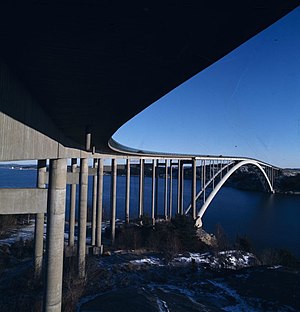Almöbron
Coordinates: 58 ° 3 ′ 34 ″ N , 11 ° 46 ′ 50 ″ E
| Almöbron | ||
|---|---|---|
| Almöbron | ||
| use | Road bridge | |
| Convicted | länsväg 160 | |
| Crossing of | Askeröfjord | |
| place | Stenungsund | |
| construction | Pipe arch bridge | |
| overall length | approx. 660 m | |
| Longest span | 278 m | |
| Headroom | 41 m | |
| opening | June 15, 1960 | |
| Status | collapsed on January 18, 1980 | |
| location | ||
|
|
||
The Almöbron over the Askeröfjord was the largest bridge of a three-part bridge train on the west coast of Sweden . When it was completed in 1960, it was the largest arch bridge in Europe and the largest tubular arch bridge in the world. On January 18, 1980, the structure was rammed by a ship and collapsed.
Construction of the Almöbron
The Almöbron was built by the MAN Gustavsburg plant and designed as a pipe arch bridge with an overhead carriageway. With a span of 278 meters, it exceeded the concrete Sandöbron of 1943 in Europe by 14 meters.
The German architect and industrial designer Klaus Flesche was involved in the design. 1964 was u. a. the Almöbron shown as an example of his work at the documenta III in Kassel in the Industrial Design department .
Steel pipes as structural elements have long been known in bridge construction. This was the case with the Eads Bridge with a span of 158 meters, which was the largest arch bridge in the world from 1874 to 1877. The Forth Bridge was also built from steel pipes. The cantilever bridge , built according to a different principle, had the largest span of all bridges in the world at 521 meters from its opening in 1890 to 1919.
A disadvantage of the construction of the Almöbron turned out to be the low resistance to buckling of the supporting pipe bends when forces act on the side. The structure was opened on June 15, 1960.
Its span was exceeded in Europe in 1961 by the English Silver Jubilee Bridge over the River Mersey (330 m). When it collapsed in 1980, the Almöbron was still the fourth largest arch bridge in Europe.
Arched pipe bridges have been increasingly being built in China since the 1990s. In these CFST bridges , however, the steel pipes are filled with concrete. This can largely prevent the steel pipes from buckling or buckling. Since 2012, the Bosideng Bridge has been the largest CFST bridge in the world with 530 meters, but is surpassed as an arch bridge by the Chaotianmen-Yangtze Bridge with 552 meters.
Collapse in 1980
On January 18, 1980, the unloaded, 172-meter-long bulk carrier Star Clipper in the Askeröfjord got problems with the controls when the ice drifted and drifted to port out of the narrow fairway . At 1:29 a.m., the ship rammed the supporting pipe arches of the bridge. These buckled, whereupon the 300 meter long middle section of the bridge collapsed and parts fell amidships and onto the freighter's navigating bridge. The radio systems on board were destroyed.
Power and radio had failed on board the ship. The pilot contacted the coastal radio station in Gothenburg via a portable radio. He reported "Bron är borta, stoppa trafik!" ( The bridge is gone, traffic stops. ) Until the police realized the extent of the damage, six cars and a truck fell over the edges of the bridge. A total of eight people, occupants of the crashed vehicles, were killed in the water. Nobody was injured on the freighter. Although the crew of the Star Clipper also fired emergency missiles, traffic from the island of Tjörn was only stopped after 40 minutes. The view was impaired by fog.
consequences
The Tjörnbron planned as a replacement was built right next to the collapsed bridge. As a consequence of the bridge accident, the construction of a cable-stayed bridge was chosen for the new construction of the bridge . The two H-pylons are on the opposite banks, so that no structural elements restrict the full passage height above the water. During the almost 22 month long construction period of today's bridge, the connection to the mainland was ensured via ferries and diversions via neighboring islands.
Nobody was assigned the blame. The accident investigation agency found no clear cause of the disaster.
The bridge train
Länsväg 160 connects the mainland near Stenungsund with the island of Tjörn via three bridges and a tunnel . The Stenungsöbron leads to the island of Stenungsön, the Källösundsbron, which follows directly behind the Stenungsö tunnel, leads to the small island of Kallön. From here the Almöbron and today the Tjörnbron led over the Almön peninsula to Tjörn.
Stenungsobron
The approximately 400 meter long Stenungsöbron (Lage) was opened in 1960. The 120 meter long Stenungsötunnel (Lage) connects to the bridge . It opened on September 13, 1957.
Källösundsbron
The 300 meter long Källösundsbron (Lage) was opened in 1960.
Almöbron | Tjörnbron
The Tjörnbron (Lage) has replaced the collapsed Almöbron since November 9, 1981 and, with a span of 386 meters, is the third largest cable-stayed bridge in Sweden. It is 664 meters long, 15 meters wide, has a span of 386 meters and a clearance for ships of 43 meters.
- Recordings of bridges and tunnels
Web links
- Olympus. Göteborgs-Posten, accessed July 22, 2017 .
Individual evidence
- ↑ IMO 6826200. Norwegian owner, registered in Liberia.
- ↑ Tjörnbrokatastrofen (March 29, 2009, Swedish)
- ↑ Göteborgs-Posten: Olycksnatten (Swedish, accessed on July 22, 2017)









